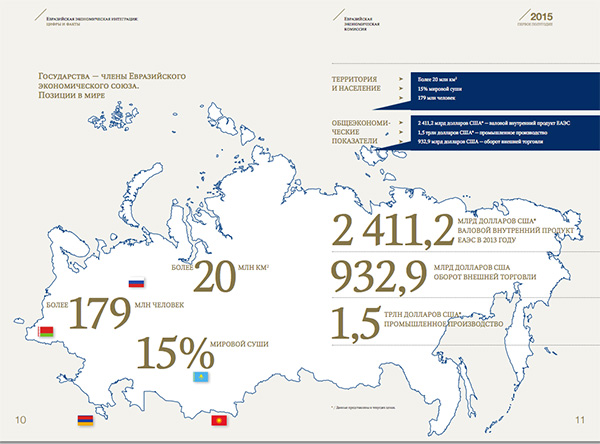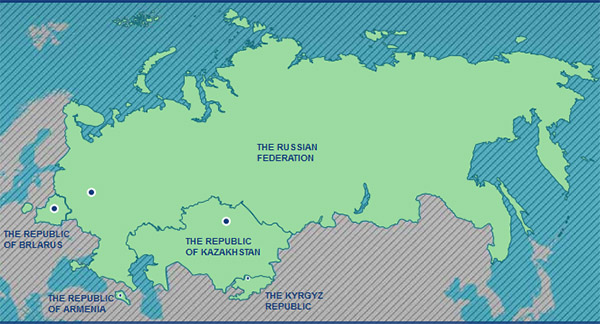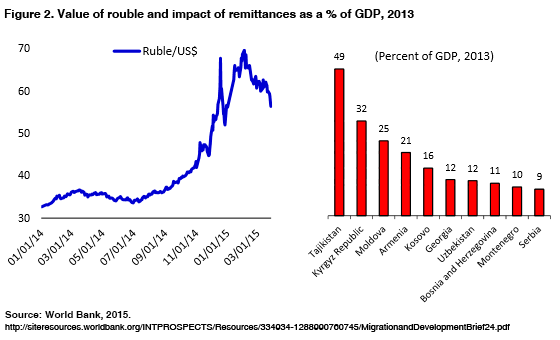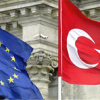Theme
The Eurasian Economic Union –officially in existence since 1 January 2015– is the most ambitious attempt yet at economically integrating the post-Soviet space. What are its successes and limitations so far? How does it alter Russia’s relations with the West? Should the EU engage it as a partner?
Summary
The creation by Armenia, Belarus, Kazakhstan and Russia (to be soon followed by Kyrgyzstan) of a Eurasian Economic Union (EEU) crowns a decades-long process aimed at the restructuring and gradual integration of the post-Soviet space. Moscow has high hopes for the EEU, and expects to use it as a platform through which to reinforce its leading role in the region and to vindicate its status as a great power in a multipolar global order. Additionally (though less conspicuously), Moscow hopes to benefit economically from the EEU, in particular, by using it to claw back part of the commercial ground already lost to the EU, China and the US. The birth of the EEU is thus a considerable foreign-policy coup for Vladimir Putin, but one which might yet prove to be short-lived. The EEU’s existence begins at a highly uncertain and volatile time for the Russian economy, plagued by economic sanctions, capital flight, currency devaluation and low hydrocarbon prices. The disadvantages of joining the EEU are becoming increasingly manifest, and its record on commercial integration is mixed. Critically, the EEU’s life has begun with the noticeable absence of the Ukraine, which Russia had tried hard to cudgel and wheedle into membership –in the process causing the onset of armed conflict there–. The EEU is also precarious in the structural sense: it is, essentially, an elite project taking root in a political context in which corruption is rife and legal standards feeble. Though some have called for the EU’s engagement with the EEU, at the time of writing no honest dialogue, let alone beneficial partnership, seems either likely or possible between the two blocs. And yet time now plays on Brussels’ side.
Analysis
“The distinction between the factual and visionary senses of ‘Eurasian Union’ is important because the Russian leadership often juxtaposes them when stating its wishes and objectives.”
The term ‘Eurasian Union’ has become the shorthand for the Eurasian Economic Union (EEU, or Евразийский Экономичеcкий Cоюз – Evraziiskii Ekonomicheskii Soyuz), an international organisation established through a 1,000-page treaty signed by Belarus, Kazakhstan and Russia on 29 May 2014. The document marked New Year’s Day of 2015 as the EEU’s effective inauguration date. Armenia soon volunteered (or perhaps, more accurately, was soon ‘encouraged’ to do so) to become a cosignatory to the agreement in October 2014, gaining full membership on 2 January 2015. Kyrgyzstan, currently a candidate state, is scheduled to join before the year 2015 is out. The EEU has further extended invitations to Azerbaijan and Tajikistan (the latter’s frictions with Kyrgyzstan make its membership unlikely for now) and suggested that Uzbekistan follow suit (Tashkent has already clarified this will not be the case). Its current and scheduled membership overlaps with the so-called Union State between Russia and Belarus, and almost coincides with that of the Collective Security Treaty Organisation, which also includes Tajikistan.1
The EEU’s fundamental function is to establish a common economic area based on the (eventual) free circulation of goods, capital and labour. In spirit and institutional design it is loosely modelled on the EU and has provisions for the full creation of a single market along with the development of common production and transport infrastructure –progress is uneven, of course, and the development of a single market in key sectors like energy has been postponed until 2025–. Critically, the EEU clears the way for a closer coordination of monetary policy and leaves open the possibility of a currency union.2 The map below (Fig. 1, released on the EEU’s presentational brochure of 2015, but based on 2013 and 2014 data), offers an overall idea of its considerable dimensions.
Figure 1. Basic EEU figures (see translation in the main text below) based on data up to June 20143

According to official EEU figures, the organisation includes over 179 million people, covers more than 15% of the world’s surface (20 million km2) and generates a combined GDP of US$2411,2 billion –an estimate on 2013 prices–. To give an indication of its relative size, and following IMF data (GDP/PPP), the EEU’s economy was, roughly, seven times smaller than that of the US and the EU, six times smaller than China’s and about half the size of India’s, slightly surpassing Brazil’s.4 Further, the EEU turned over US$932.9 million in foreign trade and was capable of industrial output worth US$1.5 trillion. Unsurprisingly, the Russian Federation accounts for over four fifths of its entire GDP, population size and geographical surface. Russia is overwhelmingly the organisation’s centre of economic and demographic gravity.
Politically and diplomatically, the EEU represents the highest and institutionally most comprehensive stage of economic integration within the geography of the former Soviet Union. It is the culmination of a sustained, if often uneven and faulty, effort at gradually coordinating trade, investment, monetary policy and economic cooperation within the post-Soviet space. The process goes back all the way to the treaty founding the Commonwealth of Independent States (CIS). Though at different times other ex-Soviet Republics have played an active role in that progression, its most consistent drivers have been Russia, Belarus and Kazakhstan. It is therefore hardly surprising that the characteristics of their political systems (including, alas, the most negative ones, such as corruption, authoritarianism and a high degree of concentration of wealth and power in the hands of a minute corporatist elite) should appear stamped on the EEU’s origins and evolution, beyond its official institutional design. Plainly, the vertical nature of Eurasian integration makes it especially vulnerable to economic fluctuations, leadership changes and international instability –exactly the conditions which have dominated post-Soviet affairs over the past year–.
To complicate matters, the term ‘Eurasian Union’ denotes something which goes well beyond the EEU. Writ large, this other Eurasian Union is essentially a geopolitical, if not a territorial, concept, evoking an eventual integration of all the peoples that, notwithstanding their national differences and political sovereignty, make up the liquid geography of ‘Eurasia’. In its fullest version, then, this other Eurasian Union could be described as the institutional intergovernmental expression of a civilisational entity (or is it identity?) formed by all those who inhabit the hazy in-between lands of Europe and Asia, while being neither Asian nor European.
The distinction between the factual and visionary senses of ‘Eurasian Union’ is important because the Russian leadership often juxtaposes them when stating its wishes and objectives. A good (if not isolated) example of this can be found in President Putin’s speech at the 2013 Valdai International Discussion Club, where he argued that the future of the EEU was not to be seen only as a collection of mutually beneficial agreements but as a ‘project for the defence of the identity of peoples of a historical Eurasian space in a new age and a new world’.5 Further, in an earlier piece for Izvestiya (2011), the then Prime Minister Putin explained that the EEU was an open-ended project, providing a bridge ‘towards the next, higher level of integration: Eurasian integration’.6
In this way (deliberately or not) Putin has sometimes fused the actual construction of the Eurasian Union (EEU), with both the idea of a transitional phase towards a deeper stage of Eurasian integration and a broader historical process involving the potential re-articulation of an alleged Eurasian civilisation around Russian culture and values. Additionally, Putin’s Eurasian idea recognises the realities of the 21st century (as the Kremlin understands them). First (and in case anyone still harboured any hopes), Eurasian integration is not/cannot be seen as an effort to restore the USSR.7 Secondly, Eurasian integration reflects the fact that the international system is increasingly multipolar, with Russia as one great power axis (державa – derzhava) among several others. Thirdly, it recognises that the world economy is moving towards global integration, and here, whatever the specific Russian variations on the free-market theme, the Kremlin’s commitment to capitalism and ‘trade liberalisation’ is made clear beyond any possible doubt. Eurasian integration, we are assured, is about conjugating Russia’s own best national interests with its growing role within global capitalism.8
The Russian elite’s outlook on Eurasian integration is thus multifaceted and often vague. It sits between far-reaching aspirations and bare compromises leaving open visible gaps between overall interests, actual capabilities and concrete realities. As a consequence, the EEU can only be, from its very inception, the object of great expectations and considerable disappointments for the Kremlin. Particularly in the context of friction with the West and given the high Russian ambitions it feeds, the EEU’s existence and profile will continue to be defended by Russia, regardless of its shortfalls and limitations and no matter the level of disaffection of its other members. The Russian elite sees the EEU as a strategic and symbolic priority and so it is committed to doing whatever it takes to maintain and defend it. This, however, will prove costly, especially in the short and mid terms. Given the project’s elite-driven nature it is likely that pressure and arm-twisting will increasingly displace incentives and cooperation as the EEU’s chief unifying logic.
How does the EEU work and who does it work for?
The EEU’s roots lie in a number of negotiations and agreements conducted under the auspices of the CIS during the mid-1990s, with two of those meriting special mention. The first was a treaty signed in January 1995 promising the creation of a Customs Union (CU, Таможенный союз – Tamozhennyi Soyuz) originally between Russia, Belorussia and Kazakhstan, and later coming to include Kyrgyzstan (1996) and Tajikistan (1997). The second important step, designed to promote and strengthen the original CU proposals, was the March 1996 Agreement for Increased Cooperation in the Economic and Humanitarian Spheres. It was signed by Belarus, Kazakhstan and Russia and established a Eurasian Economic Community (EurAsEc, Евразийскoe Экономичеcкoe Сообщество – Evraziiskoe Ekonomicheskoe Soobshchestvo). EurAsEc came into official existence on 10 October 2000, and from that point also included Kyrgyzstan and Tajikistan (as well as Uzbekistan between 2005 and 2008).9
While the CIS’s ability to articulate a process of economic or institutional integration had proved insufficient throughout the 1990s –mostly given the low commitment of its members and its focus on security issues– Putin successfully used EurAsEc as a platform for a more selective and substantial integration effort in the 2000s. Putin, and then Dmitry Medvedev (President between May 2008 and May 2012) prioritised Eurasian integration, in great part as a challenge to what they saw as the West’s intensifying and illegitimate encroachment on its near abroad (ближнее зарубежье – bliznee zarubezhye): in particular, the Colour revolutions in the Ukraine, Georgia and Kyrgyzstan and the EU’s inception of the Eastern Partnership (EaP) after 2003. The effort culminated in 2007 with the establishment of a CU from 1 January 2010 as well as the creation, from 1 January 2012, of a Single Economic Space (SES, Единoe экономическоe пространствo – Edinoe ekonomicheskoe prostranstvo) to oversee the steps for the creation of a single market. The last stage in the Putin/Medvedev integration roadmap was the creation of the EEU as a legal entity in 2015 (that future is now the present).
Internally, the EEU is, in appearance, designed in the image of the EU, with a permanent executive body (the Eurasian Economic Commission) formed by a College and a supervisory body called the Council (at the deputy-prime-ministerial level). The Commission, however, must abide by the resolutions of the Eurasian Intergovernmental Council (at the prime-ministerial level) and, in turn, it must abide by the decisions of the Supreme Eurasian Economic Council (heads of state). Additionally, there is a Court of the EEU, whose headquarters are in Minsk, which resolves disputes and guarantees that members abide by the EEU’s rules. However, the parallels with the EU begin to vanish here. At the insistence of Belarus and especially Kazakhstan, the EEU, unlike the EU, has no legislative branch. Within the CU most decisions required approval by a two-thirds majority of votes but, simultaneously, the weighting system implied that no decision could be taken without Russia. Within the EEU, however, decisions have to be reached by unanimity, a clear attempt by Moscow to allay any fears that the new organisation might only end up institutionalising Russian domination. In practice, however, most general decisions are taken by the Supreme Council, and dropped on inferior-level organs which supply the technical substance and concentrate on the nitty-gritty. Ironically, the unanimity rule does not always act as a check on Russian power. Operationally, it forces members to call frequent meetings of the Supreme EEU council, where Russian diplomatic and political influence is most visibly exerted. In practice, therefore, the power of decision in the EEU is highly concentrated, harnessing the broader process of Eurasian integration to the interests and whims of its elites and institutionalising mutual elite dependence and Russian control.10
From an economic standpoint, the foundation of the EEU is based on the CU and SES, thus naturally predicated on the elimination of internal customs barriers, and the adoption of a common tariff level for trade with third countries. All that had to be achieved in some form of balance with the provisions of the World Trade Organisation (WTO), of which Russia, Armenia and Kyrgyzstan are members. Up to 2014 the average tariff levels of most EEU states were considerably lower than Russia’s. As a result, a country like Kazakhstan ended up adopting a much higher tariff level for third countries, which precludes it from the benefits of trade with the EU and China, to an enormous loss for its economy: this adjustment additionally complicates Kazakhstan’s on-going accession to the WTO as well as the status of other EEU members within it.
The problems derived from Russia’s overwhelming economic and political weight in the organisation have become even more visible after the EU and US-sponsored sanctions began to hit the Russian economy. By the end of 2014, capital flight from Russia had reached a record US$151.5 billion; if this were not enough, the Ministry of Finance (MinFin) estimates 2015 levels to be between US$100 billion and US$130 billion.11 Compounded by the very adverse effect of persistently low international oil prices since October 2014, the rouble began to lose value from October 2014. In the worst moments of the depreciation (mid-December 2014), the Russian Central Bank raised interest rates to 17% (a 100% hike) and spent over US$80 billion in foreign reserves (about a fifth of the total) to keep its currency from sinking even deeper. Despite these desperate measures, the rouble continued to fall until February 2015, shedding about a quarter of its strength to the dollar and the euro in the process. At the time of writing, the Russian economy is in recession, expected to shrink by over 3% in 2015: inflation is in double digits, unemployment (5.8%) is at a 13-year high and real wages are contracting.12
The damage inflicted by the Russian crisis on the economies of the EEU has been extensive, thus substantially reducing its economic appeal and raising concerns that it is only making their lot worse. The problems have been mainly two. First, in the context of the rouble’s devaluation within a customs union, non-Russian goods have suddenly become uncompetitive relative to depreciated Russian merchandise. Belarus paired its currency to the rouble, so it has been able to survive the worst blows; Kazakhstan, on the other hand, has been hit very hard, being forced to depreciate the tenge by almost 20% in 2014, and using up an estimated US$2 billion every month to prevent the national currency from sliding further.13 Secondly, the contraction of the Russian economy is drying up remittances from Central Asian migrant workers; in fact, remittances to the region are declining more rapidly than anywhere else on the planet. This is particularly serious given that Tajikistan (invited to join the EEU) and Kyrgyzstan (a prospective member) are the world’s two most remittance-dependent economies (see Figure 2).
The value of remittances is expected to continue falling deep into 2015: by 12% in Belarus, by 18% in Armenia and Kazakhstan and by 23% in Kyrgyzstan, where this source of value accounts for a third of GDP.14
Taking into account that commercial integration within the region actually narrowed by 13% in the first quarter of 2014, and that members continue to denounce Russian non-compliance on basic provisions concerning the circulation of goods, the EEU’s economic record already seems deficient.15 In the wake of the crisis, the EEU is not delivering more intraregional trade (in fact, all evidence suggests that it is strengthening Russia’s bilateral commercial links to the other members and, ironically, some members’ bilateral relations with the EU); nor is it providing a chance for local Belarusian or Kazakh industries to compete in the world market; nor is it helping the Armenian and Kyrgyz remittance economies; and, finally, nor does it seem to be helping diversify and develop the region. In fairness, the EEU can still claim one success (and it is not an unimportant one): the very fact that it has survived where analogous integration experiences in the 1990s would have folded. That said, however, the EEU requires additional incentives to trudge on, and such incentives are not derived from Eurasian economic integration per se but from an assortment of Russian carrots and sticks. For instance, Moscow has offered to front the bill of any potential WTO fine arising from the implementation of the EEU tariff regime. Additionally, it has thrown in subsidies, loans and cash transfers in bilateral deals with members like Kyrgyzstan, Belarus and Armenia, whose loyalty to the project has needed some urgent propping up. Also, Moscow continues to promise faster and better access to the Russian labour market –one of the areas in which the EEU has moved most quickly– even though Russian public opinion is widely against an increased presence of migrant workers from different corners of the former Soviet Union.
These additional economic costs are, all in all, worth it for Moscow; the EEU is Russia’s best bet against continuing Western economic and political penetration. In the post-Soviet space, only Belarus keeps Russia as its main trading partner; in all other cases Russia comes second or even third to the EU and, particularly in Central Asia, to China. Critically, the EEU goes some distance to alleviating the Kremlin’s ‘day-after-tomorrow’ anxieties and ensures its influence in the region after the dreaded disappearance of Lukashenko, Nazarbayev, or indeed, Putin himself. The EEU is, as far as Moscow is concerned, an antidote against a potential new round of elite disentanglement from Russian control (such as that witnessed in the Ukraine following Yanukovich’s flight).
Russia, the EEU and the EU
“(…) the EU has a huge stake in closely observing the evolution of Eurasian integration and monitoring its ability to survive into 2016.”
In the context of the deep and protracted breakdown in Russia’s relations with the West and, particularly, of the long-stalling EU-Russia partnership, several voices, both in academic and policy circles, have begun vindicating the EEU’s potential as a platform from which to end the current stalemate. Last November, for instance, Germany’s Foreign Minister, Frank-Walter Steinmeier, advised that contacts between both organisations might go a long way to defuse mutual tensions and suspicions, adding that such an initiative is heartily welcomed by EEU members like Kazkhstan.16 The Russian leadership, in its turn, continues to state its wish for closer cooperation; Steinmeier’s counterpart in Moscow, Sergey Lavrov, has repeated the EEU’s offer of a free trade agreement with the EU.17
As some analysts have argued, a European acknowledgement of the EEU as an equal partner could be a way of reassuring Moscow that the EU’s eastern enlargement is not a relentless, never-ending expansion process, but rather one built on the recognition that there can be different, legitimate and not necessarily exclusive frameworks for post-Soviet integration. Accordingly, in engaging with the EEU, the EU would be able to deal with Russia in a space in which its decision-making power is curtailed by its other members’ veto rights (as shown above, the EEU’s resolutions must be agreed on unanimously). So ironically, it is claimed, the very thing which triggered off the Ukrainian crisis might still offer a way of overcoming it.18 For others still, the EEU is bound to end up cooperating with the EU. In fact, they argue, the scope for mutual benefit and concerns implied by this partnership would be so vast that any substantial links would have to come from an inter-regional ‘megadeal’ between the two blocs; one that might start with trade liberalisation but would necessarily have to reach out to a much deeper and more comprehensive level in the longer term.19
Clearly, the obvious stumbling block when thinking about possible EU-EEU links concerns the future of states which find themselves in between, such as the Ukraine and, to a lesser extent, Moldova, Georgia and Azerbaijan. Of course, the possibility of avoiding ‘either or’ decisions, and seeking closer relations with all neighbours (West and East) is always there: closer trade integration and even free-trade agreements with both the European and Eurasian spaces are possible, at least in principle. Indeed, European policy-makers are right to stress the fact that an Association Agreement within the Deep and Comprehensive Free Trade Agreement (DCFTA) with the Ukraine would not prevent it from seeking closer commercial ties to Russia if it were to choose so.20 It should be noted that the EU’s stance on this, while commendable now, was not as constructive when it mattered, at a crucial moment in 2013 when Yanukovich was unceremoniously rebuffed for proposing precisely this type of EU-Russia-Ukraine triadic relation. But leaving that aside for the moment, the more important point is that complementary associations with both the EEU and EU are impossible at the point of substantial membership. The EEU, for instance, is based on a customs union that would render incompatible any simultaneous EU-sponsored DCFTA deal. At the point of a customs union, then, the EEU does draws the line, handing non-member states a clear ‘in-or-out’ choice.
In any case, this is not solely a technical issue, but a political one: both the EU and Russia overplayed their hand in the run-up to the Vilnius summit of November 2014, when Yanukovich fatefully decided to turn down the Association Agreement with the EU. In other words, it was both the EU’s and Russia’s political behaviour (rather than a technical or legal impossibility) that helped chaos break out in the Ukraine. Both sides, in their very different degrees of responsibility for the ensuing conflict, would do well to change this mind-set in the future, especially if EU-EEU dialogue is to be credible.
More generally, however, for the EU to acknowledge the EEU as a partner would also imply crediting Russia’s international leadership in an important regional organisation and, by extension, implicitly accepting its legitimacy as hegemon, even when, as argued here, this legitimacy frequently derives from coercive and elite-driven measures. To put it bluntly, Belarus’s and Kazakhstan’s membership of the EEU stem from a range of interests and possibilities which have no resemblance to those underpinning Armenia’s or Kyrgyzstan’s ‘Eurasian choice’ (in their case, they chose what they could). Contrary to what some have argued, even if Brussels were to show Moscow that it accepts Eurasian integration for those who ‘choose’ it, it is at best unlikely that, reciprocally, Moscow might therefore feel compelled to recognise the Ukraine’s or Georgia’s hypothetical ‘European choices’. At any rate, such speculations can only make sense if it is conveniently agreed to forget the Russian Federation’s recent annexation of the Crimea and its continuing efforts in rendering other Ukrainian territories ungovernable from Kiev. It is far more likely that the fate of the Crimea has been sealed, at least in the short and mid-term, by the need to find some workable compromise with Russia on the Donbass.
Conclusions
The successful creation of the EEU marks a key change in post-Soviet politics; the Russian elite is heavily invested in its durability and is ready to make sacrifices in order to sustain it. At the same time, the EEU is seriously challenged by its own political and economic contradictions. In the context of sanctions, countersanctions and open conflict in the Donbass, the economic basis on which to broker cooperation between the EU and EEU is, to say the least, limited. For as long as the Kremlin is haunted by the spectre of the Ukraine’s potential EU membership, a substantive EU-EEU dialogue is likely to remain perfunctory and superficial, pragmatically confined by the progress of hostilities. Nevertheless, the EU has a huge stake in closely observing the evolution of Eurasian integration and monitoring its ability to survive into 2016.
Gonzalo Pozo Martín
Lecturer in International Political Economy at the Department of European and International Studies, King’s College London, and since September 2014 a researcher on the ‘The Vision of Eurasia’ project sponsored by the Baltic Sea Foundation and Södertörn University in Stockholm
1 The Union State was created by Russia and Belarus in 1996 (established since 1999) in an attempt to forge a confederation; former Soviet republics such as Kazakhstan or Moldova have at different times expressed an interest in joining while Abkhazia and South Ossetia currently have observer status. The Collective Security Treaty Organisation is a security and military alliance formed originally in May 1992.
2 In practice, the problems derived from the rouble devaluation have, for the time being, dampened any appetite for a currency union. ‘Lukashenko: edinaya balyuta EAES budet ne pri moei presidentskoi zhizni’ (‘Lukashenko: there will be no single EEU currency during my Presidency’), RiaNovosti, 29/I/2015.
3 These are relatively conservative valuations and are anyway subject to permanent variations and revisions. If one considers World Bank GDP/PPP data from 2014, for instance the overall economic size of the EEU reaches a more impressive US$4 trillion.
4 Eurasian Economic Commission (2015), ‘Evraziiskaya ekonomicheskaya integratsiya. Tsifry i Fakty’ (Eurasian economic integration. Figures and facts), II/2015. GDP/PPP comparative figures based on IMF Data and Statistics (January 2013-April 2015).
5 ‘Будущий Евразийский экономический союз, о котором мы заявляли, о котором мы много говорим последнее время, это не просто набор взаимовыгодных соглашений. Евразийский союз – это проект сохранения идентичности народов, исторического Евразийского пространства в новом веке и в новом мире’ (emphasis added). See footage of this fragment at https://www.youtube.com/watch?v=SsXyfoVcHxM (especially from 0’30’’).
6 ‘на следующий, более высокий уровень интеграции – к Евразийскому союзу’. Vladimir Putin (2011), ‘Novyi integratsionnyi proekt dlya Evrazii – budushee, kotoroe rozhdaetsya segodnya’ (‘The new integration project for Eurasia – A future which is being born today], Izvestiya, 3/X/2011.
7 Presenting the EEU as an attempt to restore the USSR by stealth makes for attention-grabbing headlines. To give but two examples (from reputable Polish media outlets), see ‘Niewielu Chętnych do nowego ZZZR’ (‘Few keen on new USSR’), Gazeta Wyborcza, 13/X/2014; and ‘Unia Eurazjatycka konkurencyjna dla Europy?’ (‘Is the Eurasian Union a competitor for Europe?’), Polskieradio.pl, 3/I/2015. In his Izvestiya piece, Putin calls such speculations ‘naïve’.
8 Putin, 2011.
9 All these treaties and agreements are available from the website of the Eurasian Economic Union.
10 A notorious example concerns Armenia’s EEU membership, which followed after Russian pressure prevented it from pursuing an association agreement with the EU.
11 ‘MinFin ozhidaet ottok kapitala iz Rossii v 2015 godu v $90-100 mlrd’ (‘Ministry of Finance is expecting capital flight from Russia at $90-100 billion in 2015), RiaNovosti, 2/III/2015.
12 World Bank (2015), Russia’s Monthly Economic Development, 10/IV/2015.
13 This dynamic has presented the Russian economy with some perverse advantages; for instance, the higher demand for cheaper Russian cars in Kazakhstan has allowed the industry to survive the worst consequences of Western sanctions. ‘Rossiiskie avtozavody namereny udvoit’ eksport’ (‘Russian car makers intend to double exports’), TASS, 15/II/2015.
14 World Bank (2015), ‘Migration and development brief 2015’, 13/IV/2015, p. 19.
15 ‘Tamozhennyi Soyuz ne srastaetsya torgovlei’, Kommersant, 19/V/2014.
16 Frank-Walter Steinmeier, ‘Europäische Friedensordnung steht auf dem Spiel’ (‘European peace framework is at stake’), Die Welt, 16/XI/2014.
17 ‘Lavrov hopes free trade zone for EU, Eurasian Economic Union still possible’, Sputnik, 8/IV/2015.
18 This, at any rate, is the gist of a recent comment by Ivan Krastev & Mark Leonard (2014), ‘The new European disorder’, European Council on Foreign Relations Essay, XI/2014.
19 Evgenyi Vinokurov (2014), ‘Мегасделка двух союзов’ (‘A megadeal of two Unions’), Izvestiya, 2/X/2014.
20 But note that what are meant here are commercial relations with Russia and the EEU within the framework of CIS free-trade agreements. Naturally, even the mere prospect of the Ukraine joining the EEU is unlikely.




